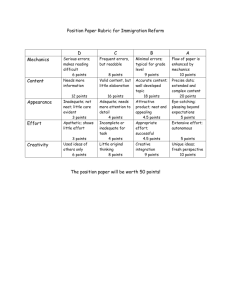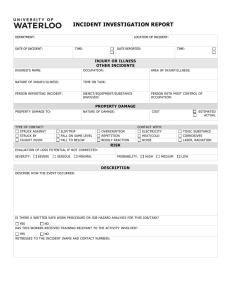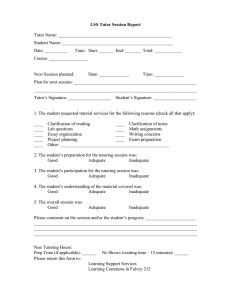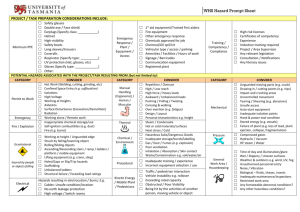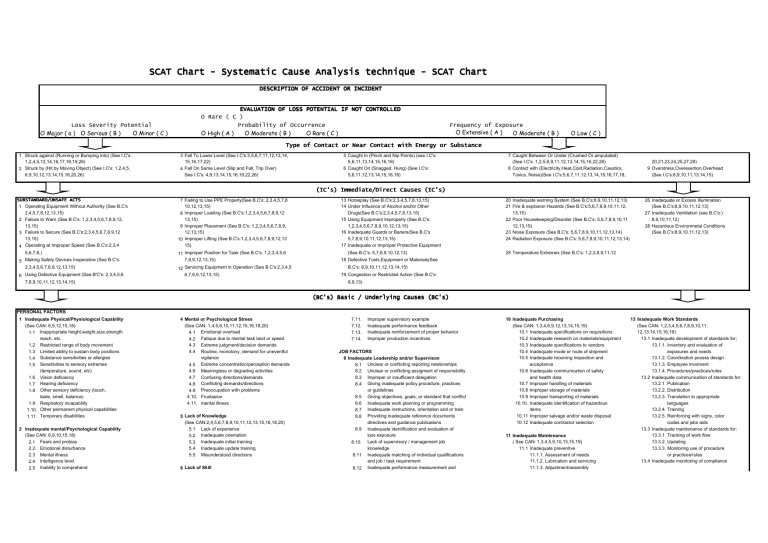
SCAT Chart - Systematic Cause Analysis technique - SCAT Chart DESCRIPTION OF ACCIDENT OR INCIDENT Loss Severity Potential O Major ( a ) O Serious ( B ) O Minor ( C ) EVALUATION OF LOSS POTENTIAL IF NOT CONTROLLED O Rare ( C ) Probability of Occurrence O High ( A ) O Moderate ( B ) O Rare ( C ) Frequency of Exposure O Extensive ( A ) O Moderate ( B ) O Low ( C ) Type of Contact or Near Contact with Energy or Substance 1 Struck against (Running or Bumping into) (See I.C's: 1,2,4,5,12,14,16,17,18,19,26) 2 Struck by (Hit by Moving Object) (See I.C's: 1,2,4,5, 6,9,10,12,13,14,15,16,20,26) 3 Fall To Lower Level (See I.C's:3,5,6,7,11,12,13,14, 15,16,17,22) 4 Fall On Same Level (Slip and Fall, Trip Over) See I.C's: 4,9,13,14,15,16,19,22,26) 5 Caught In (Pinch and Nip Points) (see I.C's: 5,6,11,13,14,15,16,18) 6 Caught On (Snagged, Hung) (See I.C's: 5,6,11,12,13,14,15,16,18) 7 Caught Between Or Under (Crushed Or amputated) (See I.C's: 1,2,5,6,9,11,12,13,14,15,16,22,28) 8 Contact with (Electricity,Heat,Cold,Radiation,Caustics, Toxics, Noise)(See I.C's:5,6,7,11,12,13,14,15,16,17,18, 20,21,23,24,25,27,28) 9 Overstress,Overexertion,Overhead (See I.C's:8,9,10,11,13,14,15) (IC's) Immediate/Direct Causes (IC's) SUBSTANDARD/UNSAFE ACTS 1 Operating Equipment Without Authority (See B.C's 2,4,5,7,8,12,13,15) 2 Failure to Warn (See B.C's: 1,2,3,4,5,6,7,8,9,12, 13,15) 3 Failure to Secure (See B.C's:2,3,4,5,6,7,8,9,12 13,15) 4 Operating at Improper Speed (See B.C's:2,3,4 5,6,7,8,) 5 Making Safety Devices Inoperative (See B.C's 2,3,4,5,6,7,8,9,12,13,15) 6 Using Defective Equipment (See B'C's: 2,3,4,5,6 7,8,9,10,11,12,13,14,15) 7 Failing to Use PPE Properly(See B.C's: 2,3,4,5,7,8 10,12,13,15) 8 Improper Loading (See B.C's:1,2,3,4,5,6,7,8,9,12 13,15) 9 Improper Placement (See B.C's: 1,2,3,4,5,6,7,8,9, 12,13,15) 10 Improper Lifting (See B.C's:1,2,3,4,5,6,7,8,9,12,13 15) 13 Horseplay (See B.C's:2,3,4,5,7,8,13,15) 14 Under Influence of Alcohol and/or Other Drugs(See B.C's:2,3,4,5,7,8,13,15) 15 Using Equipment Improperly (See B.C's: 1,2,3,4,5,6,7,8,9,10,12,13,15) 16 Inadequate Guards or Bariers(See B.C's 5,7,8,9,10,11,12,13,15) 17 Inadequate or Improper Protective Equipment 11 Improper Position for Task (See B.C's: 1,2,3,4,5,6 7,8,9,12,13,15) 18 Defective Tools,Equipment or Materials(See 12 Servicing Equipment in Operation (See B.C's:2,3,4,5 6,7,8,9,12,13,15) 19 Congestion or Restricted Action (See B.C's: (See B.C's: 5,7,8,9,10,12,13) 20 Inadequate warning System (See B.C's:8,9,10,11,12,13) 21 Fire & explosion Hazards (See B.C's:5,6,7,8,9,10,11,12, 13,15) 22 Poor Housekeeping/Disorder (See B.C's: 5,6,7,8,9,10,11 12,13,15) 23 Noise Exposure (See B.C's: 5,6,7,8,9,10,11,12,13,14) 24 Radiation Exposure (See B.C's: 5,6,7,8,9,10,11,12,13,14) 26 Inadequate or Excess Illumination (See B.C's:8,9,10,11,12,13) 27 Inadequate Ventilation (see B.C's:) 8,9,10,11,12) 28 Hazardous Environmetal Conditions (See B.C's:8,9,10,11,12,13) 25 Temperature Extremes (See B.C's: 1,2,3,8,9,11,12 B.C's: 8,9,10,11,12,13,14,15) 8,9,13) (BC's) Basic / Underlying Causes (BC's) PERSONAL FACTORS 1 Inadequate Physical/Physiological Capability (See CAN: 6,9,12,15,18) 1.1 Inappropriate height,weight,size,strength reach, etc. 1.2 Restricted range of body movement 1.3 Limited ability to sustain body positions 1.4 Substance sensitivities or allergies 1.5 Sensitivities to sensory extremes (temperature, sound, etc) 1.6 Vision deficiency 1.7 Hearing deficiency 1.8 Other sensory deficiency (touch, taste, smell, balance) 1.9 Respiratory incapability 1.10. Other permanent physical capabilities 1.11. Temporary disabilities 2 Inadequate mental/Psychological Capability (See CAN: 6,9,10,15,18) 2.1 Fears and probias 2.2 Emotional disturbance 2.3 Mental illness 2.4 Intelligence level 2.5 Inability to comprehend 4 Mental or Psychological Stress (See CAN: 1,4,5,6,10,11,12,15,16,18,20) 4.1 Emotional overload 4.2 Fatique due to mental task laod or speed 4.3 Extreme judgment/decision demands 4.4 Routine, monotony, demand for uneventful vigilance 4.5 Extreme concentration/perception demands 4.6 Meaningless or degrading activities 4.7 Confusing directions/demands 4.8 Conflicting demands/directions 4.9 Preoccupation with problems 4.10. Frustasion 4.11. mental illness 5 Lack of Knowledge (See CAN:2,4,5,6,7,8,9,10,11,12,13,15,16,18,20) 5.1 Lack of experience 5.2 Inadequate orientation 5.3 Inadequate initial training 5.4 Inadequate update training 5.5 Misunderstood directions 6 Lack of Skill 7.11. 7.12. 7.13. 7.14. Improper supervisory example Inadequate performance feedback Inadequate reinforcement of proper behavior Improper production incentives JOB FACTORS 8 Inadequate Leadership and/or Supervison 8.1 Unclear or conflicting reporting relationships 8.2 Unclear or conflicting assigment of responsibility 8.3 Improper or insufficient delegation 8.4 Giving inadequate policy,procedure, practices or guidelines 8.5 Giving objectives, goals, or standard that conflict 8.6 Inadequate work planning or programming 8.7 Inadequate instructions, orientation and or train 8.8 Providing inadequate reference documents directives and guidance publications 8.9 Inadequate identification and evaluation of loss exposure 8.10. Lack of supervisory / management job knowledge 8.11 Inadequate matching of individual qualifications and job / task requirement 8.12 Inadequate performance measurement and 10 Inadequate Purchasing (See CAN: 1,3,4,6,9,12,13,14,15,19) 10.1 Inadequate specifications on requisitions 10.2 Inadequate research on materials/equipment 10.3 Inadequate specifications to vendors 10.4 Inadequate mode or route of shipment 10.5 Inadequate receiving inspection and acceptance 10.6 Inadequate communication of safety and health data 10.7 Improper handling of materials 10.8 Improper storage of materials 10.9 Improper transporting of materials 10.10. Inadequate identification of hazardous items 10.11 Improper salvage and/or waste disposal 10.12 Inadequate contractor selection 11 Inadequate Maintenance ( See CAN: 1,3,4,5,9,10,13,15,19) 11.1 Inadequate preventive 11.1.1. Assessment of needs 11.1.2. Lubrication and servicing 11.1.3. Adjustment/assembly 13 Inadequate Work Standards (See CAN: 1,2,3,4,5,6,7,8,9,10,11, 12,13,14,15,16,19) 13.1 Inadequate development of standards for; 13.1.1. Inventory and evaluation of exposures and needs 13.1.2. Coordination pocess design 13.1.3. Employee involment 13.1.4. Procedures/practices/rules 13.2 Inadequate communication of standards for: 13.2.1. Pubilcation 13.2.2. Distribution 13.2.3. Translation to appropriate languages 13.2.4. Training 13.2.5. Reinforcing with signs, color codes and jobs aids 13.3 Inadequate maintenance of standards for: 13.3.1. Tracking of work flow 13.3.2. Updating 13.3.3. Monitoring use of procedure or practices/rules 13.4 Inadequate monitoring of compliance 2.6 2.7 2.8 2.9 2.10. 2.11. Poor judgment Poor coordination Slow reaction time Low mwchanical aptitude Low learning aptitude Memory failure (See CAN: 2,4,5,6,7,9,10,13,15,18) 6.1 Inadequate initial instruction 6.2 Inadequate practice 6.3 Infrequent performance 6.4 Lack of Coaching 6.5 Inadequate review instruction 3 Physical or Physiological Stress (See CAN: 4,6,9,11,12,13,15,18,20) 3.1 Injury illness 3.2 Fatique due to task load or duration 3.3 Fatique due to lack of rest 3.4 Fatique due to sensory overload 3.5 Exposure to health hazards 3.6 Exposure to temperature extremes 3.7 Oxygen deficiency 3.8 Atmospheric pressure variation 3.9 Blood sugar insufficiency 3.10. Drugs 7 Improper Motivation (See CAN: 1,2,4,5,6,8,10,11,13,15,17,18) 7.1 Improper performance is rewarding 7.2 Improper performance is punishing 7.3 Lack of incentives 7.4 excessive frustation 7.5 Inappropriate agression 7.6 Improper attempt to save time or effort 7.7 Improper attempt to avoid discomfort 7.8 Improper attempt to gain attention 7.9 Inadequate dicipline 7.10. Inappropriate peer pressure 1 LEADERSHIP AND ADMINISTRATION Program Present (P), Standards (S), Compliance ( C ) 1.1 General Policy 1.2 Program Coordinator 1.3 Senior and Middle Management Participation 1.4 Management Performance Standards 1.5 Management Participation 1.6 Presentation at Management Meeting 1.7 Management Reference Manual 1.8 Management Audits Conducted 1.9 Individual Responsibility for Safety and health /Loss Control Objectives 1.10. Establishment of Annual Safety and Health /Loss Control Objectives 1.11 Joint safety & Health Committees and/or Safety and Health Representatives 1.12 Refusal to Work on Grounds of safety & Health Hazard (s) procedure 1.13 reference Library 5 ACCIDENT AND INCIDENT INVESTIGATION Program Present (P), Standards (S), Compliance ( C ) 5.1 Accident/Incident Investigation Procedure 5.2 Scope of Investigations Established 5.3 Remedial Follow-up and Action 5.4 Major Accident Announcement Used 5.5 High Potential Incident Information Used 5.6 Operating management Participation 5.7 Incident Reporting and Investigation 5.8 Accident/Incident Report Maintenance 5.9 Regular Program Monitoring 8.13 evaluation Inadequate or incorrect performance feedback 11.1.4. Cleaning or resurfacing 11.2 Inadequate repairative 11.2.1. Communication of needs 11.2.2. Scheduling of work 11.2.3. Examination of units 11.2.3. Part of substitution 9 Inadequate Engineering (See CAN: 1,2,3,4,9,12,13,14) 9.1 Inadequate assessment of loss exposures 9.2 Inadequate considerationof human factors or ergonomic 9.3 Inadequate standards, specifications and or design criteria 9.4 Inadequate monitoring of construction 9.5 Inadequate assessment of operational readiness 9.6 Inadequate or improper controls 9.7 Inadequate monitoring of initial operation 9.8 Inadequate evaluation of changes 12 Inadequate Tools and equipment (See CAN: 1,3,4,6,7,9,11,12,13,14,15,19) 12.1 Inadequate assessment of needs and risks 12.2 Inadequate human factors/ergonomics considerations 12.3 Inadequate standards or specifications 12.4 Inadequate availability 12.5 Inadequate adjustment/maintenance 12.6 Inadequate salvage and reclamation 12.7 Inadequate removal and replacement of suitable items 14 Exercise Wear and Tear (See CAN: 3,4,6,9,10,13,14,15) 14.1 Inadequate planning of use 14.2 Improper extension of service life 14.3 Inadequate inspection and/or monitor 14.4 Improper loading or rate of use 14.5 Inadequate maintenance 14.6 Use by unqualified or untrained people 14.7 Use for wrong purpose 15 Abuse or Misuse 15.1 Improper conduct that is condoned 15.1.1. Intentional 15.1.2. Unintentional 15.2 Improper conduct that is not condoned 15.2.1. Intentional 15.2.2. Unintentional (CAN) Control Action Needs (CAN) 2 MANAGEMENT TRAINING Program Present (P), Standards (S), Compliance ( C ) 2.1 Management Orientation/Induction Program 2.2 Formal Initial Training of Senior Management personnel 2.3 Formal Review and update Training of senior Management Personnel 2.4 Formal iInitial Training of Supervisory and Middle Management Personnel 2.5 Formal Review and Update Training of Supervisory and Middle Management personnel 2.6 Formal Training of program coordinator 3 PLANNED INSPECTIONS Program Present (P), Standards (S), Compliance ( C ) 3.1 Planned General Inspections 3.2 Follow-up Procedures 3.3 Inspection report Analysis 3.4 Critical Parts/Items Inspection Program 3.5 Preventive Maintenance Program 3.6 Mobile and Material-Handling Pre-Use P S C 6 TASK OBSERVATION Program Present (P), Standards (S), Compliance ( C ) 6.1 Management Directive on Importance 6.2 Complete Task Observation Program 6.3 Level of Complete Task Observations 6.4 Partial Task Observation Program 6.5 Task Observation Report Analysis 6.6 Regular Program Monitoring P P S S C C 7 EMERGENCY PREPAREDNESS Program Present (P), Standards (S), Compliance ( C ) 7.1 Coordinator Appointed 7.2 emergency Plan in Writing 7.3 Supervisory Training in First Aid 7.4 Employee Training in First Aid (10%) 7.5 Emergency Lighting and Power Adequate 7.6 Master Controls Color Coded and Labeled 7.7 Protective and Rescue Equipment 7.8 Emergency Team Training and Drills 7.9 Qualified First Aid Attendants 7.10. Organized Outside Help and Mutual Aid 7.11 Protection of Vital Records 7.12 Post Event Planning 7.13 Emergency Communication Provided 7.14 Public Safety Communications Planned P S C 10 EMPLOYEE TRAINING Program Present (P), Standards (S), Compliance ( C ) 10.1 Training Needs Analysis 10.2 Employee Training Program 10.3 Training Program evaluation 11 PERSONAL PROTECTIVE EQUIPMENT Program Present (P), Standards (S), Compliance ( C ) 11.1 Personal Protective Equipment Standards 11.2 Personal Protective Equipment Recordkeeping 11.3 Enforcement of Standards 11.4 Regular Program Monitoring P P S S C 12 HEALTH CONTROL Program Present (P), Standards (S), Compliance ( C ) 12.1 Health Hazard Identification 12.2 Health hazard Control 12.3 Information/Training/education 12.4 Industrial Hygiene Monitoring 12.5 Health Maintenance program 12.6 Professional Medical Assistance 12.7 Health Communications to Worker 12.8 Record Maintenance 14 ENGINEERING CONTROL Program Present (P), Standards (S), Compliance ( C ) 14.1 Design Engineering Safety and Health Considerations at conception and Design 8 ORGANIZATIONAL RULES S S C P S C C 13 PROGRAM EVALUATION SYSTEM Program Present (P), Standards (S), Compliance ( C ) 13.1 Comprehensive Audit of Compliance with Program standards 13.2 Comprehensive Audit of Compliance with Physical Conditions standards 13.3 Comprehensive Audit of Compliance with Fire Prevention and Control Standards 13.4 Comprehensive Audit of Compliance with Occupational Health Standards 13.5 Program Evaluation Systems Record Keeping P P C P P S S C C 16 GROUP MEETING Program Present (P), Standards (S), Compliance ( C ) 16.1 Group Meeting Held 16.2 Record of Subject, Visual Aid, Attendance, Problems Discussed 16.3 Middle and Top Management Involvement 16.4 Regular Program Monitoring 17. GENERAL PROMOTION Program Present (P), Standards (S), Compliance ( C ) 17.1 safety Bulletin Board Program 17.2 Use of program statistics and facts 17.3 Critical Topic Promotion 17.4 Use of Awards or Recognition 17.5 Program Information Publication 17.6 Group Performance Promotion 17.7 Housekeeping Promotion 17.8 Records of Program Promotion Activities 18 HIRING AND PLACEMENT Program Present (P), Standards (S), Compliance ( C ) 18.1 Physical Capability Analyses 18.2 Pre-Employment Physical examination 18.3 General Orientation/Induction Program 18.4 Pre-Employment/Pre-Placement Qualification Checks 19 PURCHASING CONTROLS Program Present (P), Standards (S), Compliance ( C ) 19.1 Purchasing Includes safety and health in Specifications and Procurement 19.2 Selection and Control of Contractor 20 OFF-THE-JOB SAFETY Program Present (P), Standards (S), Compliance ( C ) 20.1 Reporting System Established and statistics Analyzed 20.2 Off-the-job safety Information Communicated P S C P S C P S C P S C P S C P S C Equipment Inspections 3.7 Alternative Conditions Reporting System 3.8 Planned general Inspection Report Maintenance 3.9 regular Program Monitoring 4 TASK ANALYSIS AND PROCEDURES Program Present (P), Standards (S), Compliance ( C ) 4.1 Management Directive on Importance 4.2 Critical Task Inventory 4.3 Task Analysis and Task Procedure Objectives 4.4 Task Analysis and Procedures for Critical Task Completed and regularly Updated 4.5 Safety and Health Hazards in Critical task Analyses and procedures 4.6 Regular program Monitoring P S C Program Present (P), Standards (S), Compliance ( C ) 8.1 General safety and Health Rules 8.2 Specialized Work Rules 8.3 Work Permit and specialized procedures Systems 8.4 Rule education and Review Program 8.5 Rule Compliance Effort 8.6 Use of Educational Signs and Color Codes 8.7 Regular program Monitoring 9 ACCIDENT/INCIDENT ANALYSIS Program Present (P), Standards (S), Compliance ( C ) 9.1 performance statistics Computed and used 9.2 Occupational Injury and Illness Analysis 9.3 Property and Equipment Damage Identification and analysis 9.4 Problem Solving project Teams P S C 14.2 14.3 P S C process Engineeing Safety and Health Consideration at Conception and Design Regular Program Monitoring 15 PERSONAL COMMUNICATIONS Program Present (P), Standards (S), Compliance ( C ) 15.1 Training in Personal Communication Technique 15.2 Job Orientation/Induction New/Transferred People 15.3 Proper Task Instruction Traning and Use 15.4 Planned Personal Contact Program 15.5 Regular Program Monitoring LEGEND P S C P Do we have program standards for this activity? S Are existing standards adequate? C Is there full compliance with standards?
